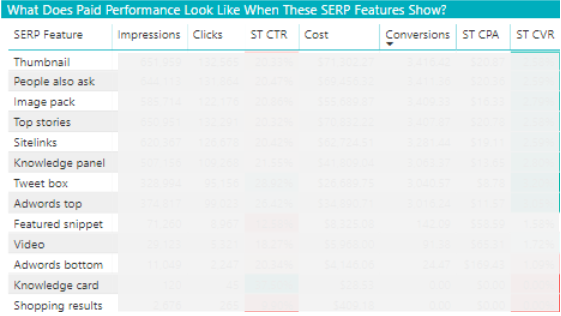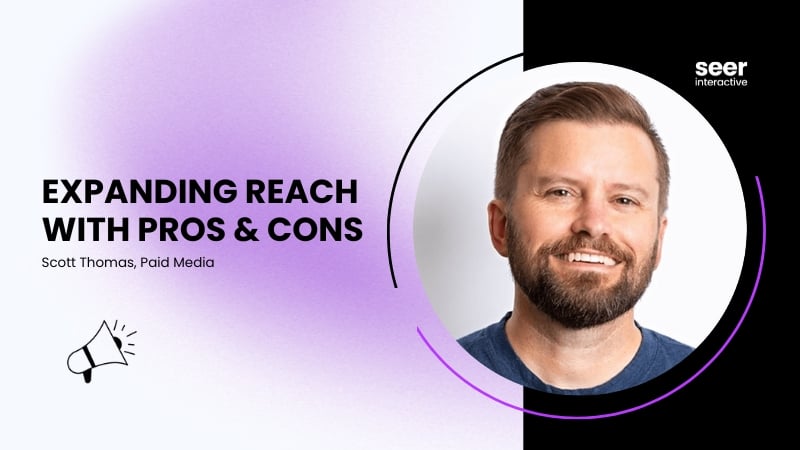At Seer, we like to think about search holistically – as one results page, regardless of which channel the results come from. If we have organic data, why not use it to our advantage in our PPC campaigns?
Below I will walk through 5 different ways to use SEO data in PPC deliverables, including:
- SEO keyword research for PPC expansion
- Meta descriptions & title tags for PPC ad copy
- Audience research to help guide your PPC strategy and messaging
- Organic ranking data to inform PPC keyword bids and expansions
- Using SERP Feature Data to Discover if your PPC keywords have the right intent
Utilizing these tactics is dependent on your access to your SEO data and deliverables, however, these are easy ways to enhance and drive more value in your PPC deliverables if you do have access to this data!
Adding organic data to PPC deliverables also shows your client (or team) that you’re 1) aware of what your SEO team is doing, 2) knowledgeable of what data is available on the organic side, and 3) using this data to provide more value to your recommendations.
💡 Pro Tip: Using this data can also help cut down the amount of time it takes you to complete analyses, expansions, or write new ad copy because you have additional data to work with!.
1. SEO keyword research for PPC expansion
Did your SEO team just complete keyword research for a specific product line, service, or landing page? Incorporate their findings into your recommendations!
Across both PPC and SEO, we complete keyword research in order to identify words and phrases people search for. We attempt to figure out what to bid on (PPC) or what to rank for (SEO). Once your SEO team does keyword research for a particular product line, service, or landing page, leverage their findings to help inform your keyword expansion opportunities or bidding and budget recommendations.
Use cases:
- Look at the Ranking URLs: Take a look at the target keywords that the SEO team pulled together.
- If you see that a number of the ranking URLs are pages that are not necessarily a page a user would convert on or not the best possible landing page from a paid perspective (ex: blog post or landing page with no CTA), add those keywords to your PPC campaigns to drive them to a PPC landing page or a landing page that encourages users to convert.
- Find the Gaps: These target keywords are keywords that your SEO team view as relevant to your clients’ website and worthy to spend time optimizing content for based on what the SERP shows.
- Add these keywords into your PPC campaigns to ensure you’re owning the SERP for relevant keywords that match the intent of your client’s landing page or website.
2. Meta descriptions & title tags for PPC ad copy
SEO meta descriptions and title tags are similar to PPC ad copy in that you are providing information about what the user will see on the landing page, while also trying to encourage them to click. Meta descriptions are recommended to be between 50 and 160 characters while the optimal title tag length is 60 characters.
Although PPC expanded text ads have significantly more room for copy with three 30-character headlines and two 90-character descriptions, it could still be beneficial to use meta descriptions and title tags of high ranking URLs for target keywords that are present in your PPC campaigns.

3. Audience research to help guide your PPC strategy and messaging
Has your SEO team completed audience research recently by completing audience interviews and other audience research tactics? Use this to help guide your PPC strategy and messaging!
Use their research to help guide your recommendations, like the following:
- Target audience: You or your client may have a product line or service that is a bit blurry when it comes to who exactly is purchasing and how they are searching to find your product or service.
-
- Use the audience research that your SEO team put together to help guide targeting strategies that can be layered onto your PPC campaigns so that they are more strategic, targeted, and accurate.
- 💡 Pro Tip: You can also layer those audiences onto your campaigns as observations (In-Market, Affinity, etc.) in GoogleAds & BingAds and add positive bid adjustments to them if you don’t want to target only those users.
- Use the audience research that your SEO team put together to help guide targeting strategies that can be layered onto your PPC campaigns so that they are more strategic, targeted, and accurate.
- Messaging: If your SEO team’s audience research includes information around how users are searching for your clients’ product or service, use this in your ad copy.
- If you know how this audience typically refers to these products or services or how they’re searching for them, utilizing that language in ad copy will likely improve CTRs and ultimately CVRs.
- If your SEO team recently did a Reddit Analysis to see how users are talking about your product or service on Reddit, this could also be helpful in determining the type of language to use in ad copy.
4. Organic ranking data to inform PPC keyword bids and expansions
Organic ranking data can tell us how our keywords are performing in regards to our current landing pages, as well as help determine if the intent of these keywords matches the content on our landing pages. Pull organic ranks for your keywords in question, whether that’s new PPC keyword expansion or existing keywords to help determine where you need to be more present in PPC.
Use Cases:
- Low-Ranking Keywords: Prioritize keywords in your PPC campaign that are not ranking on the first page organically (rank >10).
- 💡 Pro Tip: Label these keywords as “High Priority” and ensure that they are not limited by budget (to an extent) and maintain top Impression Share since your (or your clients’) site is not showing on the first page of the SERP organically..
- High-Ranking Keywords: A keyword with a high organic ranking indicates that the keyword is organically relevant and that the landing page content is relevant to the intent of the keyword. Keywords with high organic rankings should definitely be added to your account.
5. Using SERP Feature Data to Discover if your PPC keywords have the right intent
Take a look at the entire SERP when your ads are showing. What does it tell you? At Seer, we like to look at what organic SERP features are showing when our PPC ads are also showing. Using a table like the one below, we can easily see where CPAs are high or where conversion volume is low when certain SERP features are also showing.
SERP feature information allows us to gather insights on search intent of the keywords we’re bidding on, as well as the queries that are matching to our keywords.
For example, in the table below we are able to see what performance looks like when specific SERP features are also showing. If CPAs are high or CTRs are low for any specific SERP feature, that may indicate misaligned intent. From there, we can then dive into the specific search queries and keywords that were driving these ads to see if we need to make recommendations to negate irrelevant search terms or pause the keyword since the intent is not correct.

These are just 5 of the ways you can use SEO data in PPC deliverables. Begin working with your SEO team to make better recommendations and provide more valuable to your clients by thinking more holistically about the entire SERP. Run into questions? Reach out for help!
Find this helpful? Be sure to subscribe to our newsletter to get more content like this and stay informed on how Seer is utilizing data cross-divisionally to provide our clients the most value – delivered straight to your inbox!


